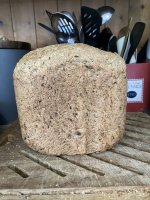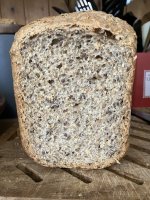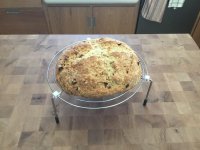we call those sheds over here.However, I don't recall seeing buildings made with concrete blocks. It's mostly stick wood framing
Which took me back (mumble) years to a classic Mork and Mindy episode (the one with the robot)I did, once. Made a casual comment about the smog and someone replied, "Oh, we don't trust air that we can't see."
Yes, well versed in the dutch oven, we used to cook with the real ones that you cover with coals (either campfire outdoors or fireplace in the house) all the time and also had two nice leCreuset ones for the kitchen that were found at a yard sale for $20 each, but when we moved to FL we planned to live on a boat for a couple years while we built our house and hence they were all given to the children before we left. We have a gas stove and the couple that will be teaching us has electric so maybe thats why they thought it had to be in a DO (they aren’t exactly culinary, more hippy granola!)
Good tip on the parchment I just checked ours and its only rated for 400F !
Cal, sorry for the slight derailment! I’ll get some pics when I start building then kitchen portion of the patio…….and don’t worry everyone I don’t build things that fall down! 😎
I have a Lodge exactly the same as yours, color and everything. I also have a Lodge camp oven, with legs and rimmed lid for coals. Using a DO is the standard beginner practice that works in all ovens. The issue with open baking in a gas oven is they vent for safety, so all the steam gets vented too. Le Cruset, don't get me started on the Snap-On of kitchen ware. Stuff costs too much and doesn't last any longer than other stuff.
When you finally get to mixing dough, mix thoroughly and extensively the first few times. Really work it. Also, if they try to teach you to autolyse (letting the flour rest in the water) for more than 1 hour, tell them its not needed. I do fermentolyse (water, flour and starter mixed, no salt) for 30-45 minutes though. But, mix it all together at once and go works well, too. But, the theory behind mixing heavy at the beginning is to help develop gluten completely throughout the dough. Successive handling is to more align the gluten strands.
The hardest part as a new bread baker is learning how to read the dough. I constantly take the temperature of the dough, it tells me how fast or slow things will go. Watch the dough, not the clock.
I can post videos and pics of dough in various stages if you ever need a reference. The best part, once you get away from the "stat at home, homestead wife" bread baking mentality that its an all day, all encompassing hobby, you will quickly figure out how to work it into your daily/weekly schedule to keep fresh bread in the house at all times.
BTW, my timer just went off, gotta pull my bread out of the oven!
we call those sheds over here.
There are houses in my area made of block construction. 50's flat top bungalows, usually small around 1000-1200ft/sq. I live in an older neighborhood, 1900-1930, current house is from '25 and is brick and stick, but true 2"x4" redwood timber. Last place was from '20, a craftsman bungalow, again all redwood framed on true 2x4 lumber. Lathe and plaster. Push pins would crumble at the thought of being forced into those walls, lol!
Not many such homes left in SoCal.
Anything with brick, taller than 10 feet is long gone unless either (a) the brick is not load bearing and (b) the brick is very well braced. Many people lost their chimneys during the Northridge quake. Chimneys like our, squat, wide, 10 feet tall, well braced, survived but those tall ones, built before the 50s, just tumbled (into the sea)...
Some of the homes built in the 50s, mid century modern, were indeed built with block walls, but these are all single story buildings, no more than 10 feet tall... with walls about 8 feet, and braced, so they tend to do fine.
When you go to two and three floors a well braced framed structure with stucco and drywall are the best. They will shake and roll, will get some cracks but by and by they stay true and they are easily patched.
Lath and plaster... nowadays you would have to be rich to afford that. From an audio standpoint they are great a sound isolation but you can do that as well with double layers of drywall ( or drywall over plywood )... specially if the top drywall is acoustically absorbing. I should know, we rebuilt our house that way.
Anything with brick, taller than 10 feet is long gone unless either (a) the brick is not load bearing and (b) the brick is very well braced. Many people lost their chimneys during the Northridge quake. Chimneys like our, squat, wide, 10 feet tall, well braced, survived but those tall ones, built before the 50s, just tumbled (into the sea)...
Some of the homes built in the 50s, mid century modern, were indeed built with block walls, but these are all single story buildings, no more than 10 feet tall... with walls about 8 feet, and braced, so they tend to do fine.
When you go to two and three floors a well braced framed structure with stucco and drywall are the best. They will shake and roll, will get some cracks but by and by they stay true and they are easily patched.
Lath and plaster... nowadays you would have to be rich to afford that. From an audio standpoint they are great a sound isolation but you can do that as well with double layers of drywall ( or drywall over plywood )... specially if the top drywall is acoustically absorbing. I should know, we rebuilt our house that way.
The secret to using drywall for maximum effectiveness is to use two layers on each side of the wall with alternate studs slightly different offsets so each side uses different studs. Then each side uses two different thicknesses of sheets. So there are two different resonances. Of course the sheets are spaced so the seams do not overlap. Fiberglass is issued as an inside fill. The most important bit is that outlets on each side of the wall do not match each other. Each should not be between the same set of studs as the opposite side outlet penetrations.
Sort of like pizza toppings! Don’t dump them all in the same place!
Sort of like pizza toppings! Don’t dump them all in the same place!
I also tried my granola bars a la Cal today. He didn't specify a weight so tried a 12lb dumbell and that seemed to do the trick. under 10 taste testers gave it 2 thumbs up and it definately holds together.
Ed, I believe you are describing the standard stick framed Party Wall. The fibreglass insulation is there to prevent condensation if one party shuts off the heat for whatever reason, it’s not for sonic isolation.
Getting stuff ready for casserole roasted chicken and aromatics tonight. Sweet potato mire poix again. Everyone in the house really loves this dish, plus its nearly a true 1 pot (Dutch oven) dinner. Only other dish needed is somewhere to put the chicken after browning.
Thoroughly enjoying the beautiful spring weather today, 73° and clear skies. Went and shot a military rifle silhouette match, my primary hobby (i.e. most expensive). Currently having a beer before starting cooking.
Cheers!
Thoroughly enjoying the beautiful spring weather today, 73° and clear skies. Went and shot a military rifle silhouette match, my primary hobby (i.e. most expensive). Currently having a beer before starting cooking.
Cheers!
Had to do the St. Patties day corned beef and cabbage a day early as the wife has to do a 12hr shift tomorrow. Tried Aldi’s corned beef for the first time and gotta say it was purty dang good! (I know,I know….its better if you do it yourself!) Irish soda bread, yellow and regular raisins with caraway seeds. 
The new Lodge pan worked flawlessly…….figured I’d break it in before making the sourdough bread tomorrow.

The new Lodge pan worked flawlessly…….figured I’d break it in before making the sourdough bread tomorrow.
Attachments
Cal,
I see fiberglass used in the walls between suites in stadiums and arenas. I think it is just standard practice, done without thought about actual use.
I see fiberglass used in the walls between suites in stadiums and arenas. I think it is just standard practice, done without thought about actual use.
Just watched part of that episode and I can't see the connection. ¯\(ツ)/¯Which took me back (mumble) years to a classic Mork and Mindy episode (the one with the robot)
Well, look at mister lah-de-dah over there. Most Australian homes are timber framed, but then we don't need to ward against bitterly cold winters.we call those sheds over here.
Having said that, my place is double brick and it's still chilly.
'you can't see air' . 'You've never been to LA'Just watched part of that episode and I can't see the connection. ¯\(ツ)/¯
We have a lot of clay here and the admiralty hogged all the wood for their ships. it blew my mind when I lived in the suburbs of chicago in an estate of identical houses that you could literally order a number 23 house from home despot and a truck would turn up with a flat pack house frame. Given I have spent most of the last 30 years living in houses built before indoor plumbing was a thing* the efficiency of the central core with services and the house built around it was an impressive bit of optimisation.Well, look at mister lah-de-dah over there. Most Australian homes are timber framed, but then we don't need to ward against bitterly cold winters.
Having said that, my place is double brick and it's still chilly.
My cooking today was limited to cheese biscuits for the lunch boxes and another attempt to make i can't believe its not nutella. Changed the recipe considerably this time and just hope it sets as hate to think what the kids will do with pour-able hazelnut chocolate spread.
*due to this many years in houses where the bathroom is downstairs, usually just off the kitchen. I only fell down the stairs once in the middle of the night 🙂
Play around with DIY chocolate truffles (candies). The interior ganache is super easy to get right on the very first try, and the exterior envelope is pretty forgiving of errors. Especially when the customers are kids, who only care about two things: CHOCOLATE!!! and also CUTE FUN TOPPINGS. Silver sprinkles, Jimmies, ground cashews, microplane shredded chocolate bars, cinnamon red-hots ... embrace your inner 8 year old and you'll have wild success
- Home
- Member Areas
- The Lounge
- The food thread








